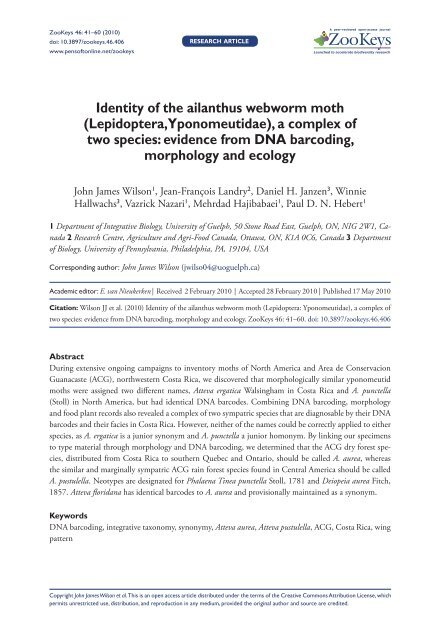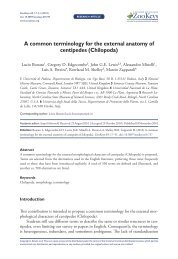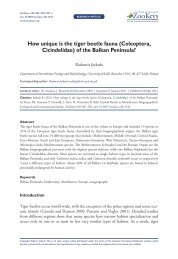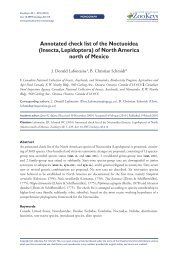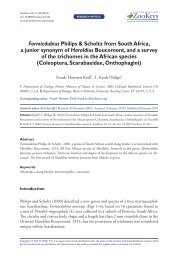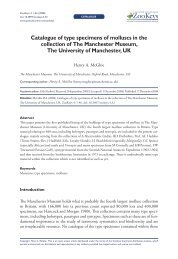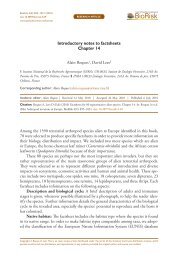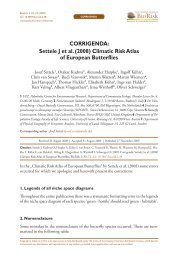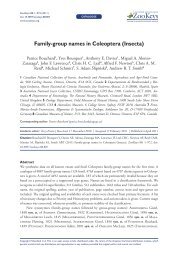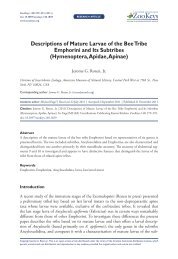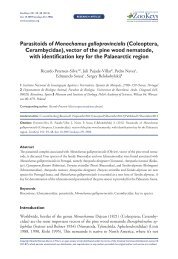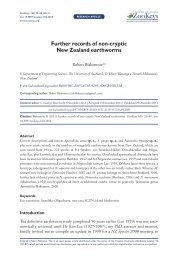(Lepidoptera, Yponomeutidae), a complex of two species - Pensoft ...
(Lepidoptera, Yponomeutidae), a complex of two species - Pensoft ...
(Lepidoptera, Yponomeutidae), a complex of two species - Pensoft ...
Create successful ePaper yourself
Turn your PDF publications into a flip-book with our unique Google optimized e-Paper software.
ZooKeys 46: 41–60 (2010)<br />
doi: 10.3897/zookeys.46.406<br />
www.pens<strong>of</strong>tonline.net/zookeys<br />
Identity <strong>of</strong> the ailanthus webworm moth (<strong>Lepidoptera</strong>: <strong>Yponomeutidae</strong>), a <strong>complex</strong>... 41<br />
RESEARCH ARTICLE<br />
Identity <strong>of</strong> the ailanthus webworm moth<br />
(<strong>Lepidoptera</strong>, <strong>Yponomeutidae</strong>), a <strong>complex</strong> <strong>of</strong><br />
<strong>two</strong> <strong>species</strong>: evidence from DNA barcoding,<br />
morphology and ecology<br />
John James Wilson 1 , Jean-François Landry 2 , Daniel H. Janzen 3 , Winnie<br />
Hallwachs 3 , Vazrick Nazari 1 , Mehrdad Hajibabaei 1 , Paul D. N. Hebert 1<br />
1 Department <strong>of</strong> Integrative Biology, University <strong>of</strong> Guelph, 50 Stone Road East, Guelph, ON, NIG 2W1, Canada<br />
2 Research Centre, Agriculture and Agri-Food Canada, Ottawa, ON, K1A 0C6, Canada 3 Department<br />
<strong>of</strong> Biology, University <strong>of</strong> Pennsylvania, Philadelphia, PA, 19104, USA<br />
Corresponding author: John James Wilson (jwilso04@uoguelph.ca)<br />
A peer-reviewed open-access journal<br />
Launched to accelerate biodiversity research<br />
Academic editor: E. van Nieukerken | Received 2 February 2010 | Accepted 28 February 2010 | Published 17 May 2010<br />
Citation: Wilson JJ et al. (2010) Identity <strong>of</strong> the ailanthus webworm moth (<strong>Lepidoptera</strong>: <strong>Yponomeutidae</strong>), a <strong>complex</strong> <strong>of</strong><br />
<strong>two</strong> <strong>species</strong>: evidence from DNA barcoding, morphology and ecology. ZooKeys 46: 41–60. doi: 10.3897/zookeys.46.406<br />
Abstract<br />
During extensive ongoing campaigns to inventory moths <strong>of</strong> North America and Area de Conservacion<br />
Guanacaste (ACG), northwestern Costa Rica, we discovered that morphologically similar yponomeutid<br />
moths were assigned <strong>two</strong> diff erent names, Atteva ergatica Walsingham in Costa Rica and A. punctella<br />
(Stoll) in North America, but had identical DNA barcodes. Combining DNA barcoding, morphology<br />
and food plant records also revealed a <strong>complex</strong> <strong>of</strong> <strong>two</strong> sympatric <strong>species</strong> that are diagnosable by their DNA<br />
barcodes and their facies in Costa Rica. However, neither <strong>of</strong> the names could be correctly applied to either<br />
<strong>species</strong>, as A. ergatica is a junior synonym and A. punctella a junior homonym. By linking our specimens<br />
to type material through morphology and DNA barcoding, we determined that the ACG dry forest <strong>species</strong>,<br />
distributed from Costa Rica to southern Quebec and Ontario, should be called A. aurea, whereas<br />
the similar and marginally sympatric ACG rain forest <strong>species</strong> found in Central America should be called<br />
A. pustulella. Neotypes are designated for Phalaena Tinea punctella Stoll, 1781 and Deiopeia aurea Fitch,<br />
1857. Atteva fl oridana has identical barcodes to A. aurea and provisionally maintained as a synonym.<br />
Keywords<br />
DNA barcoding, integrative taxonomy, synonymy, Atteva aurea, Atteva pustulella, ACG, Costa Rica, wing<br />
pattern<br />
Copyright John James Wilson et al. This is an open access article distributed under the terms <strong>of</strong> the Creative Commons Attribution License, which<br />
permits unrestricted use, distribution, and reproduction in any medium, provided the original author and source are credited.
42<br />
Introduction<br />
John James Wilson et al. / ZooKeys 46: 41–60 (2010)<br />
Th e ailanthus webworm moth is a conspicuous member <strong>of</strong> eastern North American<br />
micromoth assemblages and is commonly recorded in checklists and inventories as<br />
Atteva punctella (Stoll, 1781) (e.g. Heppner and Duckworth 1983; Ding et al. 2006;<br />
http://en.wikipedia.org/wiki/Ailanthus_webworm). Th e colloquial name refers to its<br />
association with the tree-<strong>of</strong>-heaven (Ailanthus altissima, Simaroubaceae), an ornamental<br />
introduced to Europe and North America from Asia. First planted in Philadelphia<br />
in 1784, the plant is now widely distributed across the United States and considered a<br />
serious invasive (Ding et al. 2006). Th e ailanthus webworm moth is native to the New<br />
World and its native hosts are trees in the genus Simarouba (Simaroubaceae). It is believed<br />
that once the expanding range <strong>of</strong> the tree-<strong>of</strong>-heaven reached southern Texas, this<br />
moth, presumably already present on native hosts, added this new host and expanded<br />
north on it (Becker 2009).<br />
Th e name Phalaena (Tinea) punctella was recognized as a junior homonym almost<br />
immediately after its description but has been retained through several major works<br />
(Heppner and Duckworth 1983; Covell 1984; Heppner 1984). Th e <strong>two</strong> objective replacement<br />
names proposed were Tinea punctella Fabricius, 1787, and Crameria subtilis<br />
Hübner, 1822. Th e oldest valid name to replace Phalaena punctella is Tinea pustulella<br />
but this remained overlooked until recently (Heppner 2003). Over time seven more<br />
nominal taxa were synonymized under Atteva pustulella: aurea Fitch, 1857 (Deiopeia),<br />
compta Clemens, 1861 (Poeciloptera), compta fl oridana Neumoegen, 1891 (Oeta), A.<br />
edithella Busck, 1908, A. exquisita Busck, 1912, A. ergatica Walsingham, 1914, and A.<br />
microsticta Walsingham, 1914. Interestingly there were early suspicions that A. aurea<br />
and A. pustulella might represent diff erent <strong>species</strong>, the former distributed in the United<br />
States, the latter in South America, but at the time there was insuffi cient material to<br />
support this view (Walsingham 1897). A recent taxonomic review <strong>of</strong> New World Atteva<br />
(Becker 2009) introduced several nomenclatural changes and recognized three<br />
separate <strong>species</strong> within the long-standing concept <strong>of</strong> A. pustulella: A. pustulella, A.<br />
aurea, and A. fl oridana. Th e separation <strong>of</strong> aurea from pustulella introduced by Becker<br />
was based on data presented here.<br />
Atteva is the sole genus constituting the subfamily Attevinae within the <strong>Yponomeutidae</strong>.<br />
Th e group has a pantropical distribution but at least one <strong>species</strong> (A. aurea) now<br />
has a range that extends into the temperate zone. No consistent hypotheses regarding<br />
the relationships, placement, and ranking <strong>of</strong> Attevinae have been published but the<br />
prevalent view is that they likely form a monophyletic group within the <strong>Yponomeutidae</strong><br />
(Kyrki 1990; Landry and Landry 1998; Dugdale et al. 1998; Regier et al. 2009).<br />
Th e authors are currently involved in extensive ongoing campaigns to inventory all<br />
<strong>Lepidoptera</strong> <strong>species</strong> in North America (Hebert et al. 2009; www.lepbarcoding.org) and<br />
in Area de Conservacion Guanacaste (ACG), Costa Rica (Janzen et al. 2005; Janzen<br />
et al. 2009; Burns et al. 2007; Burns et al. 2008; Burns et al. 2009; http://janzen.sas.<br />
upenn.edu/). It was during the course <strong>of</strong> these inventories that the problem concerning<br />
the identity <strong>of</strong> A. pustulella fi rst came to light. Incorporating DNA barcoding into
Identity <strong>of</strong> the ailanthus webworm moth (<strong>Lepidoptera</strong>: <strong>Yponomeutidae</strong>), a <strong>complex</strong>... 43<br />
inventories has been very eff ective at uncovering cryptic <strong>species</strong> (Hebert et al. 2004;<br />
Janzen et al. 2005; Janzen et al. 2009; Burns et al. 2009; Smith et al. 2007; Smith et al.<br />
2008; Floyd et al. 2009; Hausman et al. 2009) and revealing, then subsequently correcting,<br />
taxonomic issues (e.g. the identity <strong>of</strong> Taygetis andromeda in Janzen et al. 2009).<br />
Th is is the case presented here with the ailanthus webworm moth. When identical barcode<br />
sequences were recovered for A. pustulella in Ontario and A. ergatica in ACG, the<br />
initial response was to change all records <strong>of</strong> A. ergatica to A. pustulella. Atteva ergatica<br />
was originally described from Central America and was long thought to be a synonym<br />
<strong>of</strong> A. pustulella in North America. However, further sampling revealed <strong>two</strong> adjacent<br />
barcode clusters representing <strong>two</strong> distinct <strong>species</strong> within ACG and separable by their<br />
DNA barcodes, wing patterns, host plant and ecosystem. Th rough examination <strong>of</strong> type<br />
material and literature investigation, we discovered like Becker (2009), that the name<br />
applied to the North American ailanthus webworm was inappropriate, but also that<br />
what had been thought to be intraspecifi c variation in facies across the ACG dry forest<br />
and rain forest ecosystems actually represented <strong>two</strong> <strong>species</strong>.<br />
Th e goal <strong>of</strong> the present study was to determine the correct names for each Atteva<br />
<strong>species</strong> for inclusion into our inventories. However, we also view this study as an example<br />
<strong>of</strong> successful integrative taxonomic eff orts. Our conclusions were achieved through<br />
examination <strong>of</strong> Atteva type specimens, where available and involved a combined genitalia<br />
dissection and DNA extraction procedure (Knolke et al. 2005) and the sequencing <strong>of</strong><br />
mini-barcodes (Hausman et al. 2009; Rougerie et al. personal communication). Where<br />
type specimens have been lost, original illustrations were examined. We provide DNA<br />
barcode, morphological and ecological diagnostics for the <strong>two</strong> closely related <strong>species</strong> in<br />
ACG, formerly united under A. pustulella and recently separated again (Becker 2009).<br />
Methods<br />
As part <strong>of</strong> ongoing inventories in ACG (Janzen et al. 2005; Janzen et al. 2009) and<br />
Ontario (Hebert et al. 2009), specimens assigned to the genus Atteva were submitted<br />
to the Canadian Centre for DNA barcoding at the Biodiversity Institute <strong>of</strong> Ontario at<br />
the University <strong>of</strong> Guelph for molecular analysis. Full-length (658 bp) DNA barcodes<br />
(Hebert et al. 2003; Floyd et al. 2009) were recorded for these specimens with standard<br />
protocols (www.dnabarcoding.ca).<br />
Reared wild-caught specimens (see Janzen et al. 2009 for rearing methods) from<br />
the ACG caterpillar inventory are indicated by voucher codes <strong>of</strong> the form YY-SRNP-<br />
XXXXX, where the suffi x contains 1–5 digits. Light-caught ACG BioLep adult specimens<br />
have the same voucher code structure, but have 6 digits in the suffi x.<br />
After the discovery that specimens identifi ed as A. ergatica in ACG and A. pustulella<br />
in North America had identical DNA barcodes, an eff ort was undertaken to examine<br />
and sequence relevant type material from national collections as well as more freshly<br />
collected specimens (see specimen records in Appendix I: Dataset 1). Following the<br />
protocol <strong>of</strong> Knolke et al. (2005) DNA was extracted from old type specimens during
44<br />
John James Wilson et al. / ZooKeys 46: 41–60 (2010)<br />
genitalia dissections for those which still had the abdomen intact, otherwise DNA was<br />
extracted from a leg. From these old DNA extracts, barcodes were assembled from six<br />
PCR amplicons (Hausman et al. 2009; Rougerie et al. in preparation). Wing-patterns<br />
and genitalia preparations were qualitatively examined and compared.<br />
All sequences together with collateral information on the specimens were deposited<br />
in BOLD (www.barcodinglife.com) (Ratnasingham and Hebert 2008) in project<br />
ATTEV (Atteva <strong>of</strong> the New World). Sequences were also deposited in GenBank under<br />
accession numbers GU013569, GU692470-GU692541, HM034026-HM034136. A<br />
maximum parsimony tree was constructed in PAUP (Sw<strong>of</strong>f ord 1998; using PAUPRat,<br />
http://users.iab.uaf.edu/~derek_sikes/s<strong>of</strong>tware2.htm) to demonstrate the presence <strong>of</strong><br />
diagnostic nucleotides for each <strong>species</strong>.<br />
Results and discussion<br />
Identical barcode sequences were recovered from so-called pustulella in Ontario and A.<br />
ergatica in ACG. Further sampling in ACG revealed <strong>two</strong> adjacent barcode clusters, one<br />
comprised <strong>of</strong> specimens entirely from the ACG rain forest and feeding on new shoot<br />
tips <strong>of</strong> Simarouba amara (an exclusively rain forest <strong>species</strong>) and the other <strong>of</strong> specimens<br />
entirely from ACG dry forest and feeding on new shoot tips <strong>of</strong> Simarouba glauca (an<br />
exclusively dry forest <strong>species</strong>). Once this was realized, it became obvious that these <strong>two</strong><br />
<strong>species</strong> could be separated by their forewing colour pattern as well as by their barcodes.<br />
Further directed sampling then located the dry forest <strong>species</strong> feeding on both <strong>species</strong><br />
<strong>of</strong> Simarouba in the several-km-wide dry forest-rain forest intergrade, in some cases on<br />
the same plant <strong>of</strong> S. amara side-by-side with the rain forest <strong>species</strong>. Yet more sampling<br />
further into the rain forest ecosystem (to the east <strong>of</strong> the dry forest) revealed that the<br />
dry forest <strong>species</strong> has now moved at least 20 km into the ACG rain forest ecosystem<br />
<strong>of</strong> S. amara, in open pastures and fi eld edges, and under more xeric conditions than<br />
would have been the case were the site still covered with original rain forest. In this<br />
circumstance, the rain forest <strong>species</strong> is at present much more abundant than is the dry<br />
forest <strong>species</strong>.<br />
Our conclusion that the ACG specimens comprise <strong>two</strong> <strong>species</strong> is based on concordance<br />
(Avise and Ball 1990) between morphological, molecular and ecological<br />
characters that are diagnostic (Cracraft 1983) for each population, providing evidence<br />
for a hypothesis <strong>of</strong> genetic isolation. Th ere was no divergence in the genitalia among<br />
the <strong>species</strong> examined. Th is lack <strong>of</strong> a genital diff erence is consistent with previous morphological<br />
studies <strong>of</strong> this group (Becker 2009). Based on congruent wing patterns <strong>of</strong><br />
the A. punctella type image (Figure 2A) and the wings <strong>of</strong> our rain forest cluster, we<br />
conclude that the correct name for the rain forest <strong>species</strong> is A. pustulella, which also fi ts<br />
with its rain forest distribution in the Neotropics (Becker 2009). Based on congruent<br />
wing patterns and identical DNA barcodes with the type specimens <strong>of</strong> A. ergatica and<br />
A. edithella (Figure 1), both synonymized under A. aurea (Becker 2009), we conclude<br />
that the ACG dry forest <strong>species</strong>, which extends north to southeastern Canada, should
Identity <strong>of</strong> the ailanthus webworm moth (<strong>Lepidoptera</strong>: <strong>Yponomeutidae</strong>), a <strong>complex</strong>... 45<br />
be called A. aurea (Figure 2). Th e <strong>two</strong> correct names along with synonyms and diagnostic<br />
characteristics are listed below, along with <strong>two</strong> other Atteva <strong>species</strong> included in<br />
our inventories.<br />
Interestingly, A. aurea is more proximate in barcode to A. hysginiella than A. punctella<br />
(Table 1; Figure 1). Atteva hysginiella is geographically disjunct as a Galapagos<br />
Islands endemic (Figure 2), strikingly diff erent in coloration, and uses a diff erent host<br />
plant. Although intraspecifi c distances (Table 1) may seem high within these <strong>species</strong><br />
compared to values reported in other studies (e.g. Janzen et al. 2009), we observed no<br />
relationship between genetic distance and geographic distance or morphological diff erences<br />
(Figure 1). Short sequence lengths obtained from older specimens (see specimen<br />
records in additional fi le 1: Datasheet 1) can make phenetic distances seem larger than<br />
if a full barcode sequence (658bp) were available for comparison. Th is is a problem<br />
seen when using percentage phenetic distances but it is clear from the maximum parsimony<br />
analysis (Figure 1) and the consensus barcodes shown in Table 1, that each <strong>species</strong><br />
possesses a cohesive cluster <strong>of</strong> haplotypes with few polymorphisms, and diagnostic<br />
characters are present which separate all <strong>species</strong>.<br />
Atteva pustulella (Fabricius)<br />
Phalaena Tinea punctella Stoll, 1781: 164. Type locality: Costa Rica by neotype<br />
designated here. A primary junior homonym <strong>of</strong> Phalaena punctella Linnaeus, 1761.<br />
Tinea pastulella Fabricius, 1787: 241. Objective replacement name for Phalaena Tinea<br />
punctella Stoll, 1781. Th e spelling is a printing error for pustulella, as is clearly<br />
evident from the description.<br />
Tinea pustulella Fabricius, 1794: 292. Justifi ed emendation <strong>of</strong> T. pastulella Fabricius,<br />
1787.<br />
Lithosia pustulata Fabricius, 1798: 462.<br />
Crameria subtilis Hübner, 1822: 168. Objective replacement name for Phalaena Tinea<br />
punctella Stoll, 1781.<br />
Forewings. Th e pattern ranging from Uruguay and Argentina northwards to Costa<br />
Rica, consists <strong>of</strong> thick black outlinings around the white spots and the orange spots<br />
reduced, with the antemedial and medial orange fasciae divided into <strong>two</strong> large blotches<br />
each (Figure 3B). No other morphological features, either in colouration, other external<br />
characters or genitalia, distinguish this <strong>species</strong> from A. aurea.<br />
Habitat and food plants. Atteva pustulella caterpillars (400+) have been found<br />
only in the ACG rain forest ecosystem and feeding only on new shoots <strong>of</strong> Simarouba<br />
amara. Where the ACG rain forest intergrades with ACG dry forest, to date all caterpillars<br />
from S. amara have been those <strong>of</strong> A. pustulella (while caterpillars <strong>of</strong> A. aurea have<br />
been found on both S. amara and S. glauca in the intergrade zone) (Figure 2).<br />
Ailanthus glandulosa [=A. altissima] in Argentina (Berg 1880: 101), Castela erecta,<br />
in Saint Croix, Antilles (Walsingham, 1914: 331), C. peninsularis, C. polyandra, C.
46<br />
John James Wilson et al. / ZooKeys 46: 41–60 (2010)<br />
Figure 1. One <strong>of</strong> 199 most parsimonious trees found by the PAUPRat analysis <strong>of</strong> Atteva barcodes<br />
sequences showing the presence <strong>of</strong> diagnostic nucleotide diff erences between the <strong>species</strong>. Th e scale bar<br />
shows the number <strong>of</strong> changes. Notable specimens are highlighted in red.
Identity <strong>of</strong> the ailanthus webworm moth (<strong>Lepidoptera</strong>: <strong>Yponomeutidae</strong>), a <strong>complex</strong>... 47<br />
Figure 2. Map showing the distribution <strong>of</strong> Atteva specimens examined as part <strong>of</strong> this study. Notable<br />
specimens are highlighted in red.<br />
emory, in the United States (Powell et al. 1973: 177). Th ese are doubtful records for<br />
which either the host or the moth <strong>species</strong> may be misidentifi ed (Becker 2009).<br />
Distribution. Th is <strong>species</strong> ranges from Costa Rica, where it meets aurea,<br />
southwards to Uruguay and Argentina. It is also present in the Antilles. Becker<br />
(2009) reports several specimens from Dominica, Jamaica, Haiti and Martinique<br />
in the USNM.<br />
Neotype. Phalaena Tinea punctella Stoll, female, here designated, deposited in<br />
USNM, labelled: “Voucher: D.H. Janzen & W. Hallwachs | DB: http://janzen.sas.<br />
upenn.edu | Area de Conservacion Guanacaste, | COSTA RICA. | 04-SRNP-4574<br />
[white, printed with numbers handwritten]; “LEGS AWAY | FOR DNA” [pale yellow,<br />
printed]; genitalia slide [female symbol] | JFL 1680 [pale green, printed]; “NEO-<br />
TYPE | Phalaena Tinea | punctella | Stoll, 1781 | by J.-F. Landry 2010” [orange, partly<br />
printed, partly handwritten]. Th e specimen is unspread and is missing the right midleg<br />
which was removed for DNA extraction, but otherwise is in good condition. Barcode<br />
sequence under GenBank accession number HM034113.<br />
Additional specimen data from Janzen’s online database: latitude 10.90037º, longitude<br />
-85.37254º, elevation 500 m, Anabelle Cordoba leg., collection date 10 Sep<br />
2004 as antepenultimate larval instar feeding on Simarouba amara, pupation 16 Sep<br />
2004, adult emergence 25 Sep 2004, ACG voucher code 04-SRNP-4574. Photographs<br />
(lateral views <strong>of</strong> each side) are available in BOLD under the voucher code.
48<br />
John James Wilson et al. / ZooKeys 46: 41–60 (2010)<br />
Table 1. DNA barcodes and the nature <strong>of</strong> intraspecifi c variation for four <strong>species</strong> <strong>of</strong> Atteva.<br />
Species Number <strong>of</strong> sequences Number <strong>of</strong> unique Mean intraspecifi c<br />
haplotypes<br />
distance<br />
Atteva pustullela 23 7 0.19<br />
AACATTATATTTTATTTTTGGAATTTGAAGAGGTATAGTAGGAACTTCTTTA-<br />
AGTTTATTAATTCGAGCTGAATTAGGAAATCCTGGTTCTTTAATTGGGAATGAC-<br />
CAAATTTATAATACTATTGTCACAGCTCATGCTTTTATTATAATTTTTTTTAT{A,G}<br />
GTTATACCTATTATAATTGGAGG{A,G}TTTGGAAATTGACTTGTCCCATTAATATTAG-<br />
GAGCCCCAGATATAGCCTTTCCCCGAATAAATAACATAAGTTTTTGATTACTTC-<br />
CACCTTCTATTACCCTATTAATTGCAAGAAGTATTGTAGAAAATGGAGCAGGTACAG-<br />
GATGAACTGTATACCCACCTTTATCTTCCAATATTGCTCATGGAGGTGGTTCAGTT-<br />
GATTTAGCTATTTTTTCTCTTCATTTAGCTGGAATTTCATCTATTTTAGGAGCTATTA-<br />
ATTTTATTACTACAATTATTAATATACGAAGTAATGGTATAAATTTTGATCAAATACCTT-<br />
TATTTGTTTGAGCTGTAGGAATTACTGCTCTTTTATTATTATTATCTTTACCAGTATTAG-<br />
CAGGGGCTATTACTATACTTTTAACTGATCGAAATTTAAATACTTCATTTTTTGACCCAG-<br />
CAGGTGGTGG{A,G}GATCCAATTTTATACCAACATTTATTC<br />
Atteva aurea 112 44 0.56<br />
AACATTATATTTTATTTTTGGAATTTGA{A,G}{A,G}AGGTATAGTAGGAACTTCTTTA<br />
AGTTTATTAATTCGAGCTGAATTAGGAAATCCTGG{C,T}TC{C,T}TTAATTGG{C,T}<br />
AATGACCAAATTTACAATACTATTGTTACAGCTCATGCTTTTATTATAATTTTTTT-<br />
TATAGTTATACCTATTATAATTGGAGGATTCGGAAATTGACTTGTTCCATTA-<br />
ATATTAGGAGCTCCAGATATAGCTTTCCC{A,C,T}CGAATAAATAATATAAGTTT{C,T}<br />
TGACTACT{C,T}CCACCTTCTATTACCTTATTAATTGCAAGAAGAATTGTAGAAAAT-<br />
GGAGCAGGTACAGGATGAACTGTATACCCACCTTTATCATCTAATATTGCT-<br />
CACGGAGGTAGTTCAGTTGATTTAGCTATTTTTTCTTTACATTTAGC{C,T}<br />
GGAATTTCATCTATTTTAGG{A,G}GCTATTAATTTTATTACTACAATTATTAATATAC-<br />
GAAGTAATGGTATAAATTTTGATCAAATACCTTTATTTGTTTGAGCTGTAGGAATTACT-<br />
GCTCTTTTATTATTATTATCTTTACCAGTTTTAGC{A,G}GGAGCTATTACTATACTTTTA<br />
ACAGATCGAAATTTAAATACTTCATTTTTTGACCC{A,G}GCTGGTGG{G,T}GG{A,G}{A,G}<br />
A{C,T}CCAATTTT{A,G}TA{C,T}CAACATTT{A,G}TTT<br />
Atteva hysginiella 27 15 0.75<br />
AACATTATATTTTATTTTTGGAATTTGAAGAGGTATAGTAGGAACTTCTTTA-<br />
AGTTTATTAATTCGAGCTGAATTAGGAAA{C,T}CC{C,T}GGTTCTTTAATTGG{C,T}<br />
AACGATCAAATTTA{C,T}AATACTATTGTTACAGCTCATGCTTTTATTATAATTTTTTT-<br />
TATAGTTATACCAATTATAATTGGAGGATTTGG{A,G}AATTGACTTGT{C,T}CCATTAATA<br />
TTAGGAGCTCCAGATATAGCCTT{C,T}CCTCG{A,G}ATAAATAATATAAGTTTCTGATTA<br />
CTTCCACCTTC{A,T}{A,T}TTACTTTATTAATTGCAAGAAGAATT{G,C}TAGAAAAT{A,G}<br />
{A,G}AGCAGG{G,T}ACAGGATGAACTGTATACCCACCTTTATCATCTAATATTGCTCAC{<br />
G,T}G{A,G}GGTAGTTCAGTTGATTTAGCTATTTTTTC{C,T}TTACATTTAGCTGGAATTT<br />
CATCTATTTTAGG{A,G}GCTATTAATTTTATTACTACAATTATTAATATACGAAGTAATGG<br />
{C,T}ATAAATTTTGATCAAATACCTTTATTTGTTTGAGCTGTAGGAATTACTGCTCTTT-<br />
TATTATTATTATCTTTACCAGT{C,T}TTAGCAGGAGCTATTACTATACTTTTAACTGAT<br />
CGAAATTTAAATACTTCATTTTT{C,T}GA{C,T}CCAGC{A,G}GGTGG{A,G}GGAGA{C,T}<br />
CCAATTTTATA{C,T}CAACATTTATTT
Identity <strong>of</strong> the ailanthus webworm moth (<strong>Lepidoptera</strong>: <strong>Yponomeutidae</strong>), a <strong>complex</strong>... 49<br />
Species Number <strong>of</strong> sequences Number <strong>of</strong> unique Mean intraspecifi c<br />
haplotypes<br />
distance<br />
Atteva zebra 18 15 0.39<br />
AACTTTATATTTTATTTTTGGAATTTGAAGAGG{A,G}ATAGTCGGTACCTCATTAA-<br />
GATTTTTAATTCGAGCAGAATTAGGTAATCCTGGATTTTTAATTGGAGATGATCAAATT-<br />
TATAATACTATTGTAACAGCTCATGCTTTCATTATAATTTTTTTTAT{A,G}GTTATACCTAT-<br />
CATAATTGGAGGATTTGGTAATTGATTAGTTCCTTTAATACTAGGAGCTCCTGATATAG-<br />
CATTCCCACGAATAAATAATATAAGTTTTTGATTACTACCCCCATCTCTTACTCTTTTA-<br />
ATTTCTAGAAGAATCGTTGAAAATGGAGCAGGAACTGGATGAACAGTTTATCCACCTT-<br />
TATCTTCTAATATTGCTCATGGAGGAAGTTCTGTTGATTTAGCTATTTTTTCTTTA-<br />
CATTTAGCCGGAATTTCATCTATTTTAGGAGCTATTAATTTTATTACTACAATTAT-<br />
TAATATACGAAGTAATGGTATAAATTTTGATCAAATACCTTTATTTGTTTGAGCT-<br />
GTAGGTATTACAGCTTTACTTTTATTGTT{A,G}TCATTACCTGTTTTAGC{A,G}<br />
GGAGCTATTACTATACTTTTAACTGA{C,T}CG{A,G}AATCTTAATACTTCATTTTTT-<br />
GATCCTGCAGGTGGAGGAGACCCAATCCTTTATCAACATTTATTT<br />
Th e distance values shown are % Kimura-2-parameter distances as calculated in BOLD. Th e DNA barcodes<br />
for each <strong>species</strong> is directly below the name and statistics for each <strong>species</strong>. Th e bold-face nucleotides<br />
highlight those bases that are unique to a <strong>species</strong>, and the bracketed bases indicate the location and nature<br />
<strong>of</strong> haplotype variants.<br />
Neotype designations. Enquiries at several major institutions (AMNH, ANSP,<br />
BMNH, NMNH, NYSM, USNM, ZMUC) failed to locate the type specimens <strong>of</strong> A.<br />
aurea and A. punctella (=pustulella). Similar negative results were indicated by Becker<br />
(2009) in his recent taxonomic review <strong>of</strong> Atteva. Th e primary types <strong>of</strong> the oldest<br />
available names appear to be lost. Th e evidence brought here strongly supports the<br />
occurrence <strong>of</strong> <strong>two</strong> distinct <strong>species</strong> long subsumed under the name punctella. Th e differentiating<br />
characters are in forewing coloration, DNA barcodes, larval host plants,<br />
and habitats, as described here under each respective <strong>species</strong> and in the ‘Results and<br />
Discussion’ section. However, wing coloration is the only character that can be used to<br />
interpret the old descriptions. Th e proper application <strong>of</strong> the <strong>two</strong> names was enabled<br />
retrospectively after diff erences in life history and barcodes were discovered and superimposed<br />
on the diff erences in forewing pattern.<br />
Th e original fi gure <strong>of</strong> Atteva punctella appears on Plate 372 in the fourth volume<br />
<strong>of</strong> Cramer’s “De Uitlandsche Kapellen Asia, Africa en America” published in Amsterdam<br />
in 1780–1782 (copy in the Canadian Agriculture Library, Neatby Building, Ottawa).<br />
Following Cramer’s death in 1780, the work was completed by his associate Caspar<br />
Stoll, who authored the section containing the description <strong>of</strong> punctella (Stoll 1781;<br />
ICZN 1958). Th e original colour illustration <strong>of</strong> punctella shows distinctly the diagnostic<br />
thick black lining and reduced orange markings in the forewing characteristic <strong>of</strong> the<br />
rainforest <strong>species</strong>. Its provenance from Surinam, presumably in the coastal area near or<br />
around Paramaribo, in what we deem to have been a primary rainforest area leads us to<br />
attribute that name to the rainforest <strong>species</strong> encountered in ACG. However, the fi gure<br />
in Cramer (Figure 3A) is a very small painting on which watercolours were manually<br />
applied on individual copies <strong>of</strong> the book, so it is not possible to know how accurately
50<br />
John James Wilson et al. / ZooKeys 46: 41–60 (2010)<br />
Figure 3. A Th e original fi gure <strong>of</strong> Atteva punctella from Plate 372 in Stoll (1781). Th e illustration is 25<br />
mm wide in the work B Phalaena Tinea punctella Stoll (= A. pustulella Fabricius), specimen USNCN-<br />
CLEP00056027 (USNM) C Atteva hysginiella, specimen CNCLEP00060122 (CNC) D A. zebra, specimen<br />
CNCLEP00056033 (USNM).<br />
the fi gure represented the specimen on which it was based. It was described from an<br />
unspecifi ed number <strong>of</strong> specimens.<br />
Although we are able to distinguish the <strong>two</strong> <strong>species</strong> on forewing pattern, there is<br />
enough variation in that character, as well as in larval host and habitat for A. aurea to<br />
leave open the possibility <strong>of</strong> misapplication <strong>of</strong> that name if based on these features<br />
alone. On the other hand, the barcodes are unequivocal. Th erefore we deem it warranted<br />
to designate neotypes for both punctella Stoll and aurea Fitch in the interest <strong>of</strong><br />
clarifying the taxonomic status <strong>of</strong> those nominal <strong>species</strong> and stabilizing nomenclature.<br />
Th e neotype was selected based on availability <strong>of</strong> a full barcode without ambiguous<br />
bases in addition to matching the forewing pattern <strong>of</strong> the original illustration <strong>of</strong> punctella<br />
and being from a rainforest location. While it would have been desirable to select<br />
a specimen from a locality “as nearly as practicable from the original type locality”<br />
(ICZN 1999, Art. 75.3.6), none from Surinam was available.<br />
Atteva aurea (Fitch)<br />
Deiopeia aurea Fitch, 1857: 486. Type locality: Marion Co., Florida, USA, by neotype<br />
designated below.
Identity <strong>of</strong> the ailanthus webworm moth (<strong>Lepidoptera</strong>: <strong>Yponomeutidae</strong>), a <strong>complex</strong>... 51<br />
Poeciloptera compta Clemens, 1861: 526. Type locality: Texas, USA. Type not located,<br />
possibly lost. Synonymized by Berg, 1880: 100 (under punctella).<br />
Oeta aurera Stretch, 1873: 240. Misspelling.<br />
Oeta compta var. fl oridana Neumoegen, 1891: 123. Type locality: Upper Indian River,<br />
Florida, USA (USNM) [Holotype male examined (Figure 6A); genitalia on slide<br />
USNM 15942 prepared by JFL; attempt to recover DNA from abdomen failed].<br />
Synonymized by Heppner and Duckworth, 1983: 26 (under punctella). Re-instated<br />
as a valid <strong>species</strong> by Becker (2009). See Remarks below.<br />
Atteva edithella Busck, 1908: 85. Type locality: Maverick County, Texas, USA (J.D.<br />
Mitchell collector) (USNM type # 11362) [Holotype female examined (Figure<br />
4A); genitalia on slide USNM 15940 prepared by JFL;DNA recovered from<br />
abdomen]. Synonymized by Heppner and Duckworth, 1983: 26 (under punctella).<br />
Atteva exquisita Busck, 1912: 86. Type locality: Mobano, Coahuila, MEXICO (R.<br />
Muller collector, August) (USNM type # 14528) [Holotype male examined (Figure<br />
4B); genitalia on slide USNM 92745 prepared in 1949]. Synonymized by Heppner<br />
and Duckworth, 1983: 26 (under punctella).<br />
Atteva ergatica Walsingham, 1914: 328. Type locality: Rio Sarstoon, BELIZE (Blancaneaux<br />
collector) (BMNH) [Holotype female examined (Figure 4C); genitalia<br />
on slide BMNH-Microlep 31548 prepared by JFL; DNA recovered from abdomen].<br />
Synonymized with pustulella by Becker (2009). Th e type locality is ecotone<br />
between dry forest and rain forest, the kind <strong>of</strong> habitat occupied by ACG A. aurea<br />
where it overlaps with the distribution <strong>of</strong> A. pustulella.<br />
Atteva microsticta Walsingham, 1914: 330. Type locality: Tehuacan, Puebla, MEXICO (R<br />
Muller collector, March 1907) (USNM) [Holotype female examined (Figure 4D);<br />
genitalia on slide USNM 92765 prepared in 1940; barcoding attempted using one<br />
leg but failed. Th e <strong>species</strong> name is spelled “microstigma” on the black-bordered type<br />
label in Walsingham’s handwriting.] Synonymized with pustulella by Becker (2009).<br />
Forewings. Th e forewings are predominantly orange, with four bands <strong>of</strong> yellow spots<br />
outlined in black. Compared with pustulella the orange is more extended and the<br />
black outlines surrounding the white spots are thinner (Figure 5A). Th ere is a marked<br />
amount <strong>of</strong> variation in the number and size <strong>of</strong> pale spots but in spite <strong>of</strong> this variation<br />
aurea is clearly separated from pustulella (Figures 4–6). See Remarks below.<br />
Habitat and food plants. Caterpillars are commonly encountered in ACG dry<br />
forest feeding on Simarouba glauca (100+ records) and in the ecotone between dry forest<br />
and rain forest, found feeding on both S. glauca and S. amara. Th e aurea population<br />
has extended at least 20 kilometers into ACG rain forest in anthropogenic artifi cially<br />
more xeric conditions, feeding on S. amara as well. It is found to the north <strong>of</strong> Costa<br />
Rica in dry forest to semi-desert ecosystems, and north to southeastern Canada, feeding<br />
on Ailanthus altissima.<br />
Distribution. In North America, distributed wherever its non-native host occurs<br />
but vagrant adults are regularly found at its northern limit in eastern Ontario and<br />
southwestern Quebec beyond the host range.
52<br />
John James Wilson et al. / ZooKeys 46: 41–60 (2010)<br />
Figure 4. A Holotype <strong>of</strong> A. edithella, specimen USNMENT00656111 (USNM) B Holotype <strong>of</strong> A.<br />
exquisita from Coahuila, Mexico, specimen USNMENT00656112 (USNM) C Holotype <strong>of</strong> A. ergatica,<br />
specimen CNCLEP00060676 (BMNH); due to markedly drooped wings, <strong>two</strong> half-photos were joined to<br />
show both sides D Holotype <strong>of</strong> A. microsticta, specimen USNMENT00656110 (USNM).<br />
Remarks. Th ere is signifi cant variation in forewing coloration as attested by several<br />
synonyms. More pronounced variants with reduced forewing black linings (edithella,<br />
exquisita) were described from semi-arid regions <strong>of</strong> northern Mexico and from Texas.<br />
Among barcoded specimens is an aberrant one (CNCLEP00027027 from Maryland)<br />
in which the forewing black reticulation failed to develop except asymmetrically in<br />
one small area <strong>of</strong> the right forewing (Figure 5D). Th at specimen was collected together<br />
with many others which displayed the normal coloration (Figure 5B–C). Th ere is evidence<br />
that colour features including the relative extent <strong>of</strong> black reticulation and intensity<br />
<strong>of</strong> orange and pale yellow may be aff ected by temperature, with the black tending<br />
toward reduction at higher temperature (Powell et al. 1973).<br />
Specimens attributable to the fl oridana have barcodes unequivocally belonging to<br />
the aurea array <strong>of</strong> specimens (Figure 6C–D). Attempts to barcode the old type specimen<br />
<strong>of</strong> fl oridana failed. We maintain fl oridana as a synonym <strong>of</strong> aurea, consistent with the<br />
traditional treatment <strong>of</strong> other authors (Heppner and Duckworth 1983; Heppner 1984,<br />
2003; Covell 1984), but contrary to Becker (2009). Its status remains debatable, and it<br />
is possible for <strong>two</strong> <strong>species</strong> to have the same barcode. Barcode sharing is known to occur,<br />
albeit infrequently, among some close relatives in <strong>Lepidoptera</strong> (Hebert et al. 2009). Th e<br />
only evidence for considering fl oridana a separate <strong>species</strong> is the allegedly distinct forewing<br />
colour pattern with reduced spots (Figure 6), which is restricted to southern Florida<br />
and seems constant in sympatry with A. aurea (Becker 2009), whereas A. aurea varies<br />
considerably in forewing pattern over its wide geographic range. However, some specimens<br />
are nearly intermediate in pattern (Figure 6C) and would be questionably attributed<br />
to either aurea or form fl oridana from wing pattern alone. Larvae <strong>of</strong> the fl oridana<br />
form feed on Simarouba glauca and so overlap in host plant with aurea. It was reported
Identity <strong>of</strong> the ailanthus webworm moth (<strong>Lepidoptera</strong>: <strong>Yponomeutidae</strong>), a <strong>complex</strong>... 53<br />
Figure 5. A Neotype <strong>of</strong> Deiopeia [= Atteva] aurea, specimen CNCLEP00031092 (CNC) B–C Barcoded<br />
specimens <strong>of</strong> A. aurea from Maryland collected 4 Aug and 31 Jul 2006 respectively (specimens<br />
CNCLEP00027030 and CNCLEP00026910, CNC) D Aberrant specimen <strong>of</strong> A. aurea from Maryland<br />
collected 4 Aug 2006 (specimen CNCLEP00027027, CNC)<br />
that their larvae are distinct (Walsingham 1914: 329; Becker 2009), but this contention<br />
seems to be based on incorrectly interpreting a description <strong>of</strong> the fl oridana larva (Dyar<br />
1897) in which the <strong>two</strong> <strong>species</strong> or forms were not actually compared. Th e alleged diff erence<br />
in larvae remains unverifi ed. Specimens seemingly <strong>of</strong> the form fl oridana examined<br />
by us were all collected early in April and May and it would be interesting to see if the<br />
form is seasonally related. Specimens <strong>of</strong> A. aurea were collected at various dates from<br />
May to August in the North American part <strong>of</strong> its range.<br />
Although the type specimen <strong>of</strong> A. aurea, from Savannah, Georgia, appears to be<br />
lost, the description matches that <strong>of</strong> the ailanthus webworm moth and this is the oldest<br />
name applicable to North American populations <strong>of</strong> this Atteva. However, the original<br />
description is insuffi cient to determine the thickness <strong>of</strong> the forewing black lining and<br />
relative size <strong>of</strong> the orange and white spots, and there is no illustration <strong>of</strong> its type. Our<br />
attribution <strong>of</strong> that name is based on the original type locality which falls within the<br />
geographical range <strong>of</strong> the dry forest <strong>species</strong> and is far outside the range <strong>of</strong> the rain forest<br />
<strong>species</strong>. Th e neotype was selected based on availability <strong>of</strong> a full barcode without ambiguous<br />
bases in addition to matching the original description <strong>of</strong> the forewing pattern<br />
<strong>of</strong> A. aurea. While it would have been desirable to select a specimen from a locality “as<br />
nearly as practicable from the original type locality” (ICZN 1999, Art. 75.3.6), none<br />
from Georgia was available. Th e selected neotype is from northern Florida in a region<br />
with habitats similar to what occurs around Savannah, Georgia.
54<br />
John James Wilson et al. / ZooKeys 46: 41–60 (2010)<br />
Figure 6. A Holotype <strong>of</strong> Oeta [=Atteva] compta var. fl oridana, specimen USNMENT00656113 (USNM)<br />
C–D Barcoded specimens <strong>of</strong> A. aurea from Dade County, Florida with a wing pattern matching or<br />
approaching that <strong>of</strong> fl oridana (all in CNC) B 4 Avr 2007 (CNCLEP00031090) C 7 Avr 2007 (CN-<br />
CLEP00031091) D 8 May 1990 (CNCLEP00056231).<br />
Neotype. Deiopeia aurea Fitch, female, here designated, deposited in CNC,<br />
labelled: “[female symbol]” [printed]; “FLORIDA: Marion Co. | Ocala National<br />
Forest | Forest Road 88 | 3.9 Miles SE <strong>of</strong> SR 316 | Longleaf Pine Sandhills | 7 DEC<br />
2004 MV/BL | TERHUNE S. DICKEL | Database # | CNCLEP | 00031092”<br />
[white, printed]; “Barcodes <strong>of</strong> Life Project | Leg(s) removed | DNA extracted”<br />
[blue, printed]; “NEOTYPE | Deiopeia | aurea Fitch, 1857 / by J.-F. Landry 2010”<br />
[orange, partly printed, partly handwritten]. Th e specimen is spread and missing<br />
the left fore- and mid-legs which were removed for DNA extraction, but otherwise<br />
is in good condition (Figure 5A). Barcode sequence under GenBank accession<br />
number HM034047.<br />
Atteva hysginiella (Wallengren, 1861)<br />
Amblothridia hysginiella Wallengren, 1861: 386. Type: PANAMA (NHRS)<br />
Cydosia sylpharis Butler, 1877: [87]. Type: Albermarle Island, Galapagos, ECUADOR<br />
(BMNH). Synonymized by Meyrick, 1914: 21.<br />
Atteva monerythyra Meyrick, 1926: 278. Type: Galapagos Islands, ECUADOR (CL<br />
Collenette collector, 31 st July 1924) (BMNH). Synonymized by Landry and Landry,<br />
1998: 33.
Identity <strong>of</strong> the ailanthus webworm moth (<strong>Lepidoptera</strong>: <strong>Yponomeutidae</strong>), a <strong>complex</strong>... 55<br />
Forewings. Th e three long, slender yellowish lines on a shiny black background, along<br />
the forewings readily distinguish this <strong>species</strong> from all others in the genus (Figure 3C).<br />
Habitat and food plants. Landry and Landry (1998) gave a detailed description<br />
<strong>of</strong> adults, immatures and life-history, with the caterpillar feeding on Castela galapageia<br />
(Simaroubaceae).<br />
Distribution. Restricted to the Galapagos Islands (Figure 2). Th e type locality<br />
recorded as being in Panama has its origin in a labeling error (Becker 2009).<br />
Atteva zebra Duckworth<br />
Atteva zebra Duckworth, 1967: 71. Type: Barro Colorado Island, Canal Zone, PANA-<br />
MA (WD and SS Duckworth collectors, 9 th May 1964) (USNM).<br />
Forewings. Th e zebra pattern makes this <strong>species</strong> readily distinct from the other <strong>species</strong><br />
presented here (Figure 3D).<br />
Habitat and food plants. A. zebra is the common webworm <strong>of</strong> shoot tips <strong>of</strong> Simarouba<br />
amara saplings and adult trees in ACG rain forest (n = 123) It is more abundant<br />
than A. pustulella, but may be found on the same individual tree with A. pustulella and<br />
an occasional A. aurea in anthropogenic rain forest habitats. It has never been found<br />
on S. glauca or in ACG dry forest.<br />
Distribution. Known only from Costa Rica and Panama.<br />
Concluding remarks<br />
Th is case study demonstrates the value <strong>of</strong> combining morphological, ecological and<br />
DNA barcode information when working with similar <strong>species</strong>. Atteva is an example<br />
where seemingly confusing morphological and ecological patterns, can be defi nitively<br />
partitioned in the light <strong>of</strong> discrete data such as DNA sequences. Th e integration<br />
and synthesis <strong>of</strong> inventories, each one necessarily regionally focused, is facilitated<br />
by DNA barcodes, an effi ciently communicated online character system. Th is<br />
was demonstrated by the fact that taxonomic problems surrounding the ailanthus<br />
webworm moth persisted in the ACG for 25 years and surfaced only recently. From<br />
the starting point <strong>of</strong> DNA barcode analyses it has been relatively straightforward to<br />
reach a taxonomic conclusion by joining taxonomic knowledge in the form <strong>of</strong> the<br />
name-bearing types with ecological and morphological information. Th e purported<br />
diffi cultly in obtaining barcodes from type material has been viewed as an obstacle<br />
to the melding <strong>of</strong> DNA barcoding information with other taxonomic information.<br />
Recent studies (Hausmann et al. 2009), including this one, show that this is not<br />
necessarily the case.
56<br />
Acknowledgements<br />
John James Wilson et al. / ZooKeys 46: 41–60 (2010)<br />
We thank Rodolphe Rougerie (Biodiversity Institute <strong>of</strong> Ontario) for primer sequences<br />
for obtaining barcodes from type specimens, Robert Foottit for allowing use <strong>of</strong> his lab<br />
at the Canadian National Collection, Vitor Becker for providing an early draft <strong>of</strong> his<br />
manuscript, ACG parataxonomists for fi nding and rearing the specimens from the<br />
ACG, and BOLD team (Megan Milton and Kara Layton) and CCDB laboratory staff<br />
(Suresh Naik) for technical support. Yves Bousquet and Don Lafontaine contributed<br />
to discussions on neotypes.<br />
We thank the following individuals, curators and their institutions for specimen<br />
loans and for answering queries about types: Kevin Tuck, Natural History Museum,<br />
London, UK; Don Davis and Patricia Gentili, U.S. National Museum, Smithsonian<br />
Institution, Washington, D.C.; Jason Weintraub, Academy <strong>of</strong> Natural Sciences <strong>of</strong><br />
Philadelphia; Tim McCabe, New York State Museum, Albany; Ole Karsholt, Zoological<br />
Museum, University <strong>of</strong> Copehagen; Erik van Nieukerken, National Museum <strong>of</strong><br />
Natural History, Leiden; Terry Dickel, Homestead, Florida.<br />
Th is reseach was supported by NSF grant to D.H. Janzen DEB 0072730, Wege<br />
Foundation to Guanacaste Dry Forest Conservation, and funds and grants from<br />
NSERC and Genome Canada through the Ontario Genomics Institute to PDNH.<br />
References<br />
Avise JC, Ball RM (1990) Principles <strong>of</strong> genealogical concordance in <strong>species</strong> concepts and biological<br />
taxonomy. Oxford Surveys in Evolutionary Biology 7: 45–67.<br />
Becker VO (2009) A review <strong>of</strong> the New World Atteva Walker moths (<strong>Yponomeutidae</strong>, Attevinae).<br />
Revista Brasileira de Entomologia 53: 349–355.<br />
Berg C (1880) Observaciones sobre la familia Hyponomeutidae (continuacion). Anales de La<br />
Sociedad Cientifi ca Argentina 10: 99–109.<br />
Burns JM, Janzen DH, Hajibabaei M, Hallwachs W, Hebert, PDN (2007) DNA barcodes <strong>of</strong><br />
closely related (but morphologically and ecologically distinct) <strong>species</strong> <strong>of</strong> skipper butterfl ies<br />
(Hesperiidae) can diff er by only one to three nucleotides. Journal <strong>of</strong> the Lepidopterists’<br />
Society 61: 138–153.<br />
Burns JM, Janzen DH, Hajibabaei M, Hallwachs W, Hebert PDN (2008) DNA barcodes<br />
and cryptic <strong>species</strong> <strong>of</strong> skipper butterfl ies in the genus Perichares in Area de Conservacion<br />
Guanacaste, Costa Rica. Proceedings <strong>of</strong> the National Academy <strong>of</strong> Sciences USA 105:<br />
6350–6355.<br />
Burns JM, Janzen DH, Hallwachs W, Hajibabaei M, Hebert PDN (2009) Genitalia, DNA<br />
barcodes, and life histories synonymize Telles with Th racides - a genus in which Telles arcalaus<br />
looks out <strong>of</strong> place (Hesperiidae: Hesperiinae). Journal <strong>of</strong> the Lepidopterists’ Society<br />
63: 141–153.<br />
Busck A (1908) Descriptions <strong>of</strong> North American Tineina. Proceedings <strong>of</strong> the Entomological<br />
Society <strong>of</strong> Washington 9: 85–95.
Identity <strong>of</strong> the ailanthus webworm moth (<strong>Lepidoptera</strong>: <strong>Yponomeutidae</strong>), a <strong>complex</strong>... 57<br />
Busck A (1912) New Microlepidoptera from Mexico. Proceedings <strong>of</strong> the Entomological Society<br />
<strong>of</strong> Washington 14: 83–87.<br />
Butler AG (1877) On the <strong>Lepidoptera</strong>, Orthoptera, and Hemiptera collected during the visit <strong>of</strong><br />
H.M.S. ‘Peterel’ to the Galapagos Islands. Proceedings <strong>of</strong> the Zoological Society <strong>of</strong> London<br />
1877: 86–91.<br />
Clemens B (1861) Contributions to American Lepidopterology 7. Proceedings <strong>of</strong> the Academy<br />
<strong>of</strong> Natural Sciences, Philadelphia 1860: 522–547.<br />
Covell CV (1984) A fi eld guide to the moths <strong>of</strong> Eastern North America. Houghton Miffl in,<br />
Boston, 496 pp.<br />
Cracraft J (1983) Species Concepts and Speciation Analysis. Current Ornithology 1: 159–187.<br />
Ding J, Wu Y, Zheung H, Fu W, Reardon R, Liu M (2006) Assessing potential control <strong>of</strong> the<br />
invasive plant, Ailanthus altissima. Biocontrol Science and Technology 16: 547–566.<br />
Duckworth WD (1967) A new <strong>species</strong> <strong>of</strong> Atteva from Central America. Proceedings <strong>of</strong> the<br />
Entomological Society <strong>of</strong> Washington 69: 69–72.<br />
Dugdale JS, Kristensen NP, Robinson GS, Scoble MJ (1998) Th e Yponomeutoidea. In: Kristensen<br />
NP (Ed) <strong>Lepidoptera</strong>, Moths and Butterfl ies 1. Evolution, Systematics and Biogeography.<br />
Handbook <strong>of</strong> Zoology IV, 35. De Gruyter, Berlin, 120–130.<br />
Dyar HG (1897) Oeta fl oridana Neumoegen. Journal <strong>of</strong> the New York Entomological Society 5: 48.<br />
Fabricius JC (1787) Mantissa insectorum. Pr<strong>of</strong>t, Copenhagen, 382 pp.<br />
Fabricius JC (1794) Entomologia Systematica Part 2. Pr<strong>of</strong>t, Copenhagen, 349 pp.<br />
Fabricius JC (1798) Suplementum entomologiae sistematicae. Pr<strong>of</strong>t & Storch, Copenhagen,<br />
572 pp.<br />
Fitch A (1857) Th ird report on the noxious and other insects <strong>of</strong> the state <strong>of</strong> New York. Transactions<br />
<strong>of</strong> the New York State Agricultural Society 16: 315–490.<br />
Floyd R, Wilson JJ, Hebert PDN (2009) DNA barcodes and insect biodiversity. In: Footit RG,<br />
Adler PH (Eds) Insect Biodiversity: Science and Society. Blackwell Publishing, Oxford,<br />
417–431.<br />
Grote AR (1873) Contribution to a knowledge <strong>of</strong> North American moths. Bulletin <strong>of</strong> the Buffalo<br />
Society <strong>of</strong> Natural History 1: 73–94.<br />
Hausmann A, Hebert PDN, Mitchell A, Rougerie R, Sommerer M, Young CJ (2009) Revision<br />
<strong>of</strong> the Australian Oenochroma vinaria Guenée, 1858 <strong>species</strong>-<strong>complex</strong> (<strong>Lepidoptera</strong>, Geometridae,<br />
Oenochrominae): DNA barcoding reveals cryptic diversity and assesses status<br />
<strong>of</strong> type specimen without dissection. Zootaxa 2239: 1–21.<br />
Hebert PDN, Cywinska A, Ball SL, DeWaard JR (2003) Biological identifi cations through<br />
DNA barcodes. Proceedings <strong>of</strong> the Royal Society <strong>of</strong> London Series B-Biological Sciences<br />
270: 313–321.<br />
Hebert PDN, deWaard JR, Landry J-F (2009) DNA barcodes for 1/1000 <strong>of</strong> the animal kingdom.<br />
Biology Letters doi: 10.1098/rsbl.2009.0848.<br />
Hebert PDN, Penton EH, Burns J, Janzen DH, Hallwachs W (2004) Ten <strong>species</strong> in one: DNA<br />
barcoding reveals cryptic <strong>species</strong> in the neotropical skipper butterfl y, Astraptes fulgerator.<br />
Proceedings <strong>of</strong> the National Academy <strong>of</strong> Sciences USA 101: 14812–14817.<br />
Heppner JB (1984) <strong>Yponomeutidae</strong>. In: Heppner JB (Ed) Atlas <strong>of</strong> Neotropical <strong>Lepidoptera</strong>,<br />
Checklist Part I. W. Junk, Th e Hague, 55–56.
58<br />
John James Wilson et al. / ZooKeys 46: 41–60 (2010)<br />
Heppner JB (2003) <strong>Lepidoptera</strong> <strong>of</strong> Florida, part 1, Introduction and catalog. Arthropods <strong>of</strong><br />
Florida and neighboring land areas, vol. 17. Florida Department <strong>of</strong> Agriculture & Consumer<br />
Services, Gainsville. 670 pp.<br />
Heppner JB, Duckworth WD (1983) <strong>Yponomeutidae</strong>. In: Hodges RW, Dominick T, Davis<br />
DR, Ferguson DC, Franclemont JG, Munroe EG, Powell JA (Eds) Check list <strong>of</strong> the <strong>Lepidoptera</strong><br />
<strong>of</strong> America North <strong>of</strong> Mexico. Classey, London, 26–27.<br />
Holland WJ (1903) Th e moth book. Doubleday, Page & Co, 479 pp.<br />
Hübner J (1816-[1826]) Verzeichniss bekannter Schmettlinge. Augsburg, 431+72pp. (index).<br />
Pp. 161–240 [published in 1822].<br />
ICZN [International Commission on Zoological Nomenclature] (1958) Opinion 516. Determination<br />
under the Plenary Powers <strong>of</strong> the relative precedence to be assigned to certain<br />
works on the Order <strong>Lepidoptera</strong> (Class Insecta) published in 1775 by Pieter Cramer,<br />
Michael Denis & Ignaz Schiff ermüller, Johann Christian Fabricius, Johann Casper Fuessley,<br />
and S.A. von Rottemburg respectively. Opinions and declarations rendered by the<br />
International Commission on Zoological Nomenclature 19(1): 1–44.<br />
ICZN [International Commission on Zoological Nomenclature] (1999) International Code <strong>of</strong><br />
Zoological Nomenclature. Fourth Edition. Th e International Trust for Zoological Nomenclature,<br />
London, 306 pp.<br />
Janzen DH, Hajibabaei M, Burns JM, Hallwachs W, Remigio E, Hebert PDN (2005) Wedding<br />
biodiversity inventory <strong>of</strong> a large and <strong>complex</strong> <strong>Lepidoptera</strong> fauna with DNA barcoding.<br />
Philosophical Transactions <strong>of</strong> the Royal Society B-Biological Sciences 360(1462):<br />
1835–1845.<br />
Janzen DH, Hallwachs W, Blandin P, Burns JM, Cadiou, J-M, Chacon, I., Dapkey T, Deans<br />
A, Epstein M, Espinoza B, Franclemont J, Haber W, Hajibabaei M, Hallwachs J, Hebert<br />
P, Gauld ID, Harvey D, Hausmann A, Kitching I, Lafontaine D, Landry J-F, Lemaire C,<br />
Miller J, Miller J, Miller L, Miller S, Montero J, Munroe E, Green S, Rawlins J, Robbins<br />
R, Rodriguez J, Rougerie R, Sharkey M, Smith A, Solis MA, Sullivan B, Th iaucourt P,<br />
Wahl D, Weller S, Whitfi eld J, Willmott K, Wood DM, Woodley N, Wilson JJ (2009)<br />
Integration <strong>of</strong> DNA barcoding into an ongoing inventory <strong>of</strong> <strong>complex</strong> tropical biodiversity.<br />
Molecular Ecology Resources 9: 1–25.<br />
Kyrki N (1990) Tentative reclassifi cation <strong>of</strong> the Holarctic Yponomeutoidea (<strong>Lepidoptera</strong>).<br />
Nota Lepidopterologica 13: 28–42.<br />
Knolke S, Erlacher S, Hausmann A, Miller MA, Segerer AH (2005) A procedure for combined<br />
genitalia dissection and DNA extraction in <strong>Lepidoptera</strong>. Insect Systematics and Evolution<br />
35: 401–409.<br />
Landry B, Landry J-F (1998) <strong>Yponomeutidae</strong> <strong>of</strong> the Galapagos Islands, with the description<br />
<strong>of</strong> a new <strong>species</strong> <strong>of</strong> Prays (<strong>Lepidoptera</strong>: <strong>Yponomeutidae</strong>). Tropical <strong>Lepidoptera</strong> 9: 31–40.<br />
Meyrick E (1914) Hyponomeutidae, Plutellidae, Amphitheridae. Lepidopterorum catalogus<br />
19: 1–20.<br />
Meyrick E (1926) On the Microlepidoptera from the Galapagos Islands and Rapa. Transactions<br />
<strong>of</strong> the Entomological Society <strong>of</strong> London 74: 269–278.<br />
Neumoegen B (1891) New Rhopalocera and Heterocera. Th e Canadian Entomologist 23:<br />
122–126.
Identity <strong>of</strong> the ailanthus webworm moth (<strong>Lepidoptera</strong>: <strong>Yponomeutidae</strong>), a <strong>complex</strong>... 59<br />
Powell JA, Comstock JA, Harbison CF (1973) Biology, geographical distribution, and status <strong>of</strong><br />
Atteva exquisita (<strong>Lepidoptera</strong>: <strong>Yponomeutidae</strong>). Transactions <strong>of</strong> the San Diego Society <strong>of</strong><br />
Natural History 17: 175–186.<br />
Ratnasingham S, Hebert PDN (2007) BOLD: Th e Barcode <strong>of</strong> Life Data System (www.dnabarcoding.org).<br />
Molecular Ecology Notes 7: 355–364.<br />
Regier JC, Zwick A, Cummings MP, Kawahara AY, Cho S, Weller S, Roe A, Baixeras J, Brown<br />
JW, Parr C, Davis DR, Epstein M, Hallwachs W, Hausmann A, Janzen DH, Kitching IJ,<br />
Solis MA, Yen SH, Bazinet AL, Mitter C (2009) Toward reconstructing the evolution <strong>of</strong><br />
advanced moths and butterfl ies (<strong>Lepidoptera</strong>: Ditrysia): an initial molecular study. BMC<br />
Evolutionary Biology 9: 280 (doi: 10.1186/1471-2148-9-280).<br />
Smith MA, Wood DM, Janzen DH, Hallwachs W, Hebert PDN (2007) DNA barcodes affi rm<br />
that 16 <strong>species</strong> <strong>of</strong> apparently generalist tropical parasitoid fl ies (Diptera, Tachinidae) are<br />
not all generalists. Proceedings <strong>of</strong> the National Academy <strong>of</strong> Sciences USA 104: 4967–4972.<br />
Smith MA, Rodriguez JJ, Whitfi eld JB, Deans AR, Janzen DH, Hallwachs W, Hebert PDN<br />
(2008) Extreme diversity <strong>of</strong> tropical parasitoid wasps exposed by iterative integration <strong>of</strong><br />
natural history, DNA barcoding, morphology, and collections. Proceedings <strong>of</strong> the National<br />
Academy <strong>of</strong> Sciences USA 105: 12359–12364.<br />
Stoll C (1781) [<strong>Lepidoptera</strong>]. In: Cramer P (Ed) De Uitlandsche Kapellen IV. Baalde, Amsterdam,<br />
91–164.<br />
Stretch RH (1872–1873) Illustrations <strong>of</strong> the Zygaenidae and Bombycidae <strong>of</strong> North America.<br />
Author, San Francisco, 242 pp.<br />
Sw<strong>of</strong>f ord DL (1998) PAUP*: phylogenetic analysis using parsimony. Version 4.0b2a. Sinauer,<br />
Sunderland, Mass.<br />
Wallengren HDJ (1861) <strong>Lepidoptera</strong>. In: Fregatten Eugenies Resa, K. (Ed), Zoologia IV.<br />
Stockholm, 351–390.<br />
Walsingham, Lord [T. de Gray] (1897) Revision <strong>of</strong> the West-Indian Micro-<strong>Lepidoptera</strong>, with<br />
descriptions <strong>of</strong> new <strong>species</strong>. Proceedings <strong>of</strong> the Zoological Society <strong>of</strong> London 1897: 54–<br />
183.<br />
Walsingham, Lord [T. de Gray] (1914) Tineina, Pterophorina, Orneodina, Pyralidina and<br />
Hepialina (part). Biologia centrali-americana. Insecta. <strong>Lepidoptera</strong>-Heterocera. Vol. IV.<br />
482 pp.<br />
Zeller PC (1873) Beitrage zur Kenntniss nordamerikanischen Nachtfalter, besonders der Microlepidopteren.<br />
Verhandlungen der kaiserlich-königlichen zoologisch-botanischen Gesellschaft<br />
in Wien 23: 201–334.
60<br />
Appendix I<br />
John James Wilson et al. / ZooKeys 46: 41–60 (2010)<br />
Specimen records (XLS format) <strong>of</strong> Atteva <strong>of</strong> the New World. File format: Micros<strong>of</strong>t<br />
Excel (1997–2003). doi: 10.3897/zookeys.46.406.app.1.ds.<br />
Copyright notice: Th is dataset is made available under the Open Database License<br />
(http://opendatacommons.org/licenses/odbl/1.0/). Th e Open Database License<br />
(ODbL) is a license agreement intended to allow users to freely share, modify, and use<br />
this Dataset while maintaining this same freedom for others, provided that the original<br />
source and author(s) are credited.<br />
Citations <strong>of</strong> the datasets:<br />
Dataset published as Appendix I:<br />
Citation: Wilson JJ et al. (2010) Identity <strong>of</strong> the ailanthus webworm moth (<strong>Lepidoptera</strong>: <strong>Yponomeutidae</strong>), a <strong>complex</strong> <strong>of</strong><br />
<strong>two</strong> <strong>species</strong>: evidence from DNA barcoding, morphology and ecology. DATASET. File format: Micros<strong>of</strong>t Excel (1997–<br />
2003). doi: 10.3897/zookeys.46.406.app.1.ds. ZooKeys 46: 47–66. doi: 10.3897/zookeys.46.406


